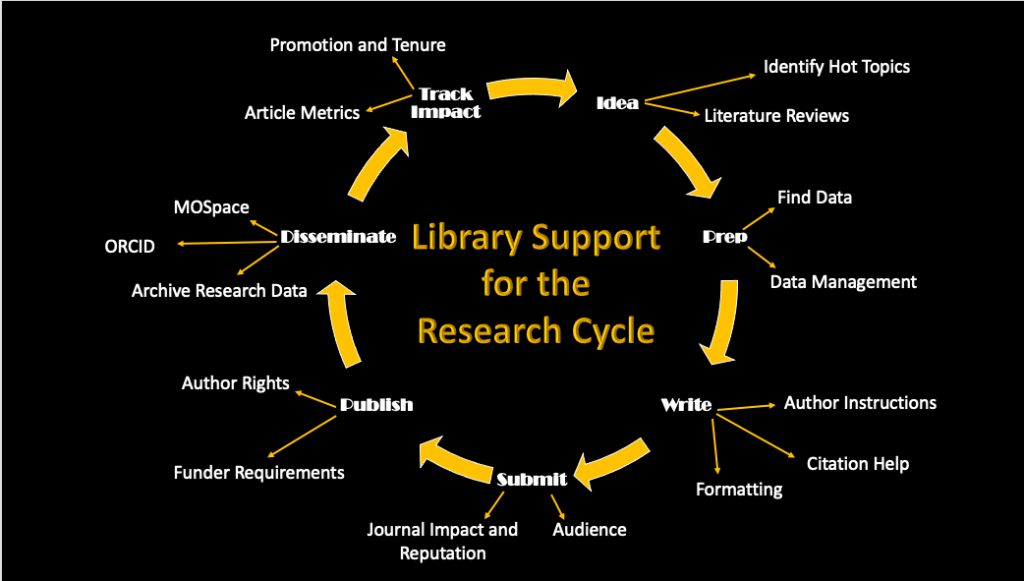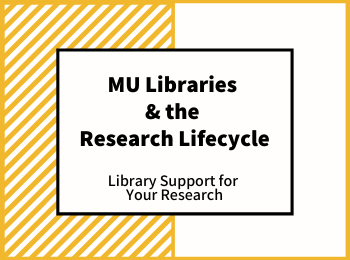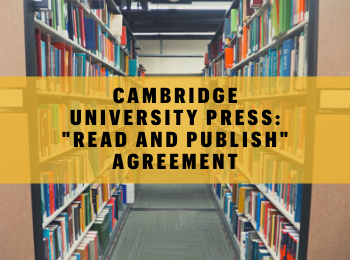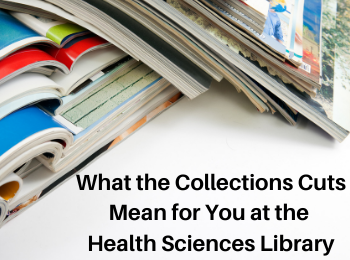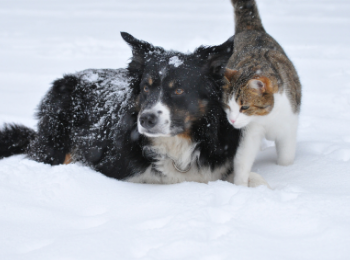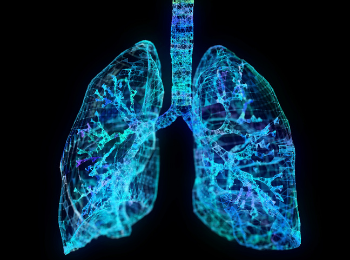2 April 2021
Below are College of Veterinary Medicine publications added to the Scopus database in the last 30 days.
PubMed Collection of MU CVM Publications 2021
Congratulations to all the recently published authors!
Note: access to the full text may be subject to library subscriptions.
Journal Articles
Kurup K, Matyi S, Giles CB, Wren JD, Jones K, Ericsson A, Raftery D, Wang L, Promislow D, Richardson A, Unnikrishnan A. Calorie restriction prevents age-related changes in the intestinal microbiota. Aging. 2021;13(5):6298-329. Epub 2021/03/22. doi: 10.18632/aging.202753. PubMed PMID: 33744869. Open Access article
Nistala R, Meuth AI, Smith C, An J, Habibi J, Hayden MR, Johnson M, Aroor A, Whaley-Connell A, Sowers JR, McKarns SC, Bender SB. DPP4 inhibition mitigates ANG II-mediated kidney immune activation and injury in male mice. American Journal of Physiology: Renal Physiology. 2021;320(3):F505-F17. Epub 2021/02/02. doi: 10.1152/ajprenal.00565.2020. PubMed PMID: 33522410; PMCID: PMC7988815 (available on 2022-03-01).
Edwards RJ, Field MA, Ferguson JM, Dudchenko O, Keilwagen J, Rosen BD, Johnson GS, Rice ES, Hillier D, Hammond JM, Towarnicki SG, Omer A, Khan R, Skvortsova K, Bogdanovic O, Zammit RA, Aiden EL, Warren WC, Ballard JWO. Chromosome-length genome assembly and structural variations of the primal Basenji dog (Canis lupus familiaris) genome. BMC Genomics. 2021;22(1):188. Epub 2021/03/18. doi: 10.1186/s12864-021-07493-6. PubMed PMID: 33726677; PMCID: PMC7962210. Open Access article
Moore SA, McCleary-Wheeler A, Coates JR, Olby N, London C. A CTSA One Health Alliance (COHA) survey of clinical trial infrastructure in North American veterinary institutions. BMC Veterinary Research. 2021;17(1):90. Epub 2021/02/27. doi: 10.1186/s12917-021-02795-z. PubMed PMID: 33632219; PMCID: PMC7905595. Open Access article
Zhang C, Yang M, Ericsson AC. Function of macrophages in disease: current understanding on molecular mechanisms. Frontiers in Immunology. 2021;12:620510. Epub 2021/03/26. doi: 10.3389/fimmu.2021.620510. PubMed PMID: 33763066; PMCID: PMC7982479. Open Access article
Montealegre F, Lyons BM. Fluid therapy in dogs and cats with sepsis. Frontiers in Veterinary Science. 2021;8:622127. Epub 2021/03/16. doi: 10.3389/fvets.2021.622127. PubMed PMID: 33718468; PMCID: PMC7947228. Open Access article
Chambers CA, Lacey CA, Brown DC, Skyberg JA. Nitric oxide inhibits interleukin-1-mediated protection against Escherichia coli K1-induced sepsis and meningitis in a neonatal murine model. Immunology and Cell Biology. 2021. Epub 2021/02/08. doi: 10.1111/imcb.12445. PubMed PMID: 33550610.
Olson RM, Dhariwala MO, Mitchell WJ, Skyberg JA, Anderson DM. Modification of the pulmonary MyD88 Inflammatory response underlies the role of the Yersinia pestis pigmentation locus in primary pneumonic plague. Infection and Immunity. 2021;89(3). Epub 2020/12/02. doi: 10.1128/IAI.00595-20. PubMed PMID: 33257532.
Alkishe A, Raghavan RK, Peterson AT. Likely geographic distributional shifts among medically important tick species and tick-associated diseases under climate change in North America: a review. Insects. 2021;12(3):1-28. doi: 10.3390/insects12030225.
Li A, Wang HX, Wang F, Fan LH, Zhao ZH, Han F, Li J, Lei WL, Zhou Q, Shi YP, Song CY, Schatten H, Sun QY, Guo XP. Nuclear and cytoplasmic quality of oocytes derived from serum-free culture of secondary follicles in vitro. Journal of Cellular Physiology. 2021. Epub 2021/02/16. doi: 10.1002/jcp.30232. PubMed PMID: 33586215.
Wang F, Fan LH, Li A, Dong F, Hou Y, Schatten H, Sun QY, Ou XH. Effects of various calcium transporters on mitochondrial Ca(2+) changes and oocyte maturation. Journal of Cellular Physiology. 2021. Epub 2021/03/12. doi: 10.1002/jcp.30327. PubMed PMID: 33704771.
Reid WR, Olson KE, Franz AWE. Current effector and gene-drive developments to engineer arbovirus-resistant Aedes aegypti (Diptera: Culicidae) for a sustainable population replacement strategy in the field. Journal of Medical Entomology. 2021. Epub 2021/03/12. doi: 10.1093/jme/tjab030. PubMed PMID: 33704462.
Warang AM, Mann FA, Middleton JR, Wagner-Mann C, Branson K. Comparison of left fourth and fifth intercostal space thoracotomy for open-chest cardiopulmonary resuscitation in dogs. Journal of Veterinary Emergency and Critical Care. 2021. Epub 2021/03/13. doi: 10.1111/vec.13059. PubMed PMID: 33709525.
Ericsson AC, Franklin CL. The gut microbiome of laboratory mice: considerations and best practices for translational research. Mammalian Genome. 2021. Epub 2021/03/11. doi: 10.1007/s00335-021-09863-7. PubMed PMID: 33689000.
Bulman CA, Chappell L, Gunderson E, Vogel I, Beerntsen B, Slatko BE, Sullivan W, Sakanari JA. The Eagle effect in the Wolbachia-worm symbiosis. Parasites & Vectors. 2021;14(1):118. Epub 2021/02/26. doi: 10.1186/s13071-020-04545-w. PubMed PMID: 33627171; PMCID: PMC7905570. Open Access article
Kelly SC, Rau CD, Ouyang A, Thorne PK, Olver TD, Edwards JC, Domeier TL, Padilla J, Grisanti LA, Fleenor BS, Wang Y, Scott Rector R, Emter CA. The right ventricular transcriptome signature in Ossabaw swine with cardiometabolic heart failure: implications for the coronary vasculature. Physiological Genomics. 2021;53(3):99-115. Epub 2021/01/26. doi: 10.1152/physiolgenomics.00093.2020. PubMed PMID: 33491589; PMCID: PMC7988741. Open Access article
Catunda APN, Alves GES, Paes Leme FO, Carvalho AM, Leise BS, Johnson PJ, Faleiros RR. Apoptosis in epithelial cells and its correlation with leukocyte accumulation in lamellar tissue from horses subjected to experimental sepsis-associated laminitis. Research in Veterinary Science. 2021;136:318-23. Epub 2021/03/24. doi: 10.1016/j.rvsc.2021.03.009. PubMed PMID: 33756380.
Lyu Z, Ghoshdastidar S, Rekha KR, Suresh D, Mao J, Bivens N, Kannan R, Joshi T, Rosenfeld CS, Upendran A. Developmental exposure to silver nanoparticles leads to long term gut dysbiosis and neurobehavioral alterations. Scientific Reports. 2021;11(1):6558. Epub 2021/03/24. doi: 10.1038/s41598-021-85919-7. PubMed PMID: 33753813; PMCID: PMC7985313. Open Access article
Shetty R, Kumar NR, Subramani M, Krishna L, Murugeswari P, Matalia H, Khamar P, Dadachanji ZV, Mohan RR, Ghosh A, Das D. Safety and efficacy of combination of suberoylamilide hydroxyamic acid and mitomycin C in reducing pro-fibrotic changes in human corneal epithelial cells. Scientific Reports. 2021;11(1):4392. Epub 2021/02/25. doi: 10.1038/s41598-021-83881-y. PubMed PMID: 33623133; PMCID: PMC7902619. Open Access article
Townsend KS, Johnson PJ, LaCarrubba AM, Martin LM, Ericsson AC. Exodontia associated bacteremia in horses characterized by next generation sequencing. Scientific Reports. 2021;11(1):6314. Epub 2021/03/20. doi: 10.1038/s41598-021-85484-z. PubMed PMID: 33737590; PMCID: PMC7973801. Open Access article
Fuchs A, Giuliano EA, Sinha NR, Mohan RR. Ocular toxicity of mustard gas: a concise review. Toxicology Letters. 2021;343:21-7. Epub 2021/02/19. doi: 10.1016/j.toxlet.2021.02.007. PubMed PMID: 33600921.
Lee J, Li Y, Li Y, Cino-Ozuna AG, Duff M, Lang Y, Ma J, Sunwoo S, Richt JA, Ma W. Bat influenza vectored NS1-truncated live vaccine protects pigs against heterologous virus challenge. Vaccine. 2021;39(14):1943-50. Epub 2021/03/16. doi: 10.1016/j.vaccine.2021.02.077. PubMed PMID: 33715905.
Budsberg SC, Torres BT, Sandberg GS. Efficacy of postoperative antibiotic use after tibial plateau leveling osteotomy in dogs: a systematic review. Veterinary Surgery. 2021. Epub 2021/03/13. doi: 10.1111/vsu.13603. PubMed PMID: 33709459.

The Zalk Veterinary Medical Library is always happy to highlight CVM Faculty Research!
Did we miss anything? Please let Kate know.
